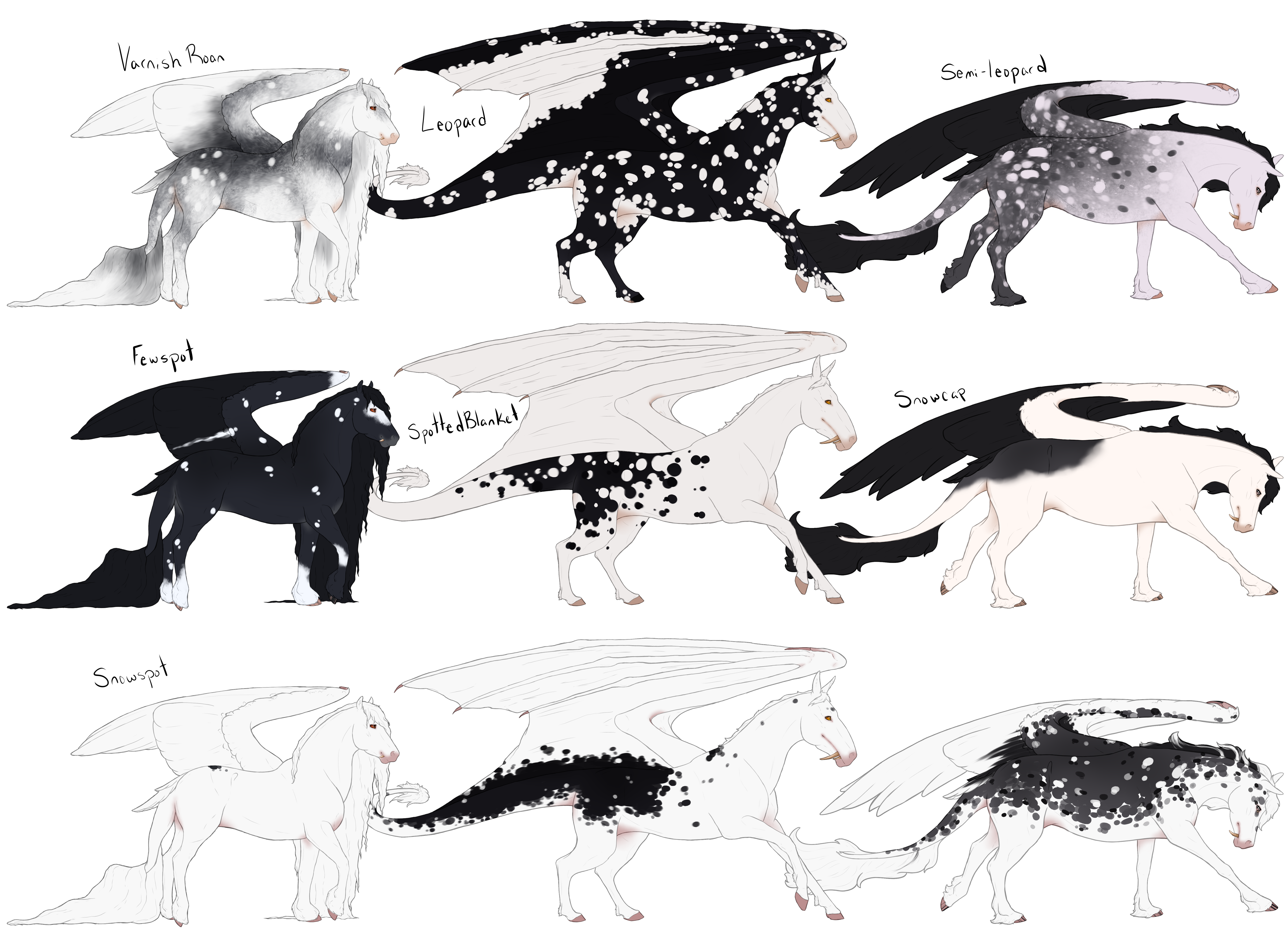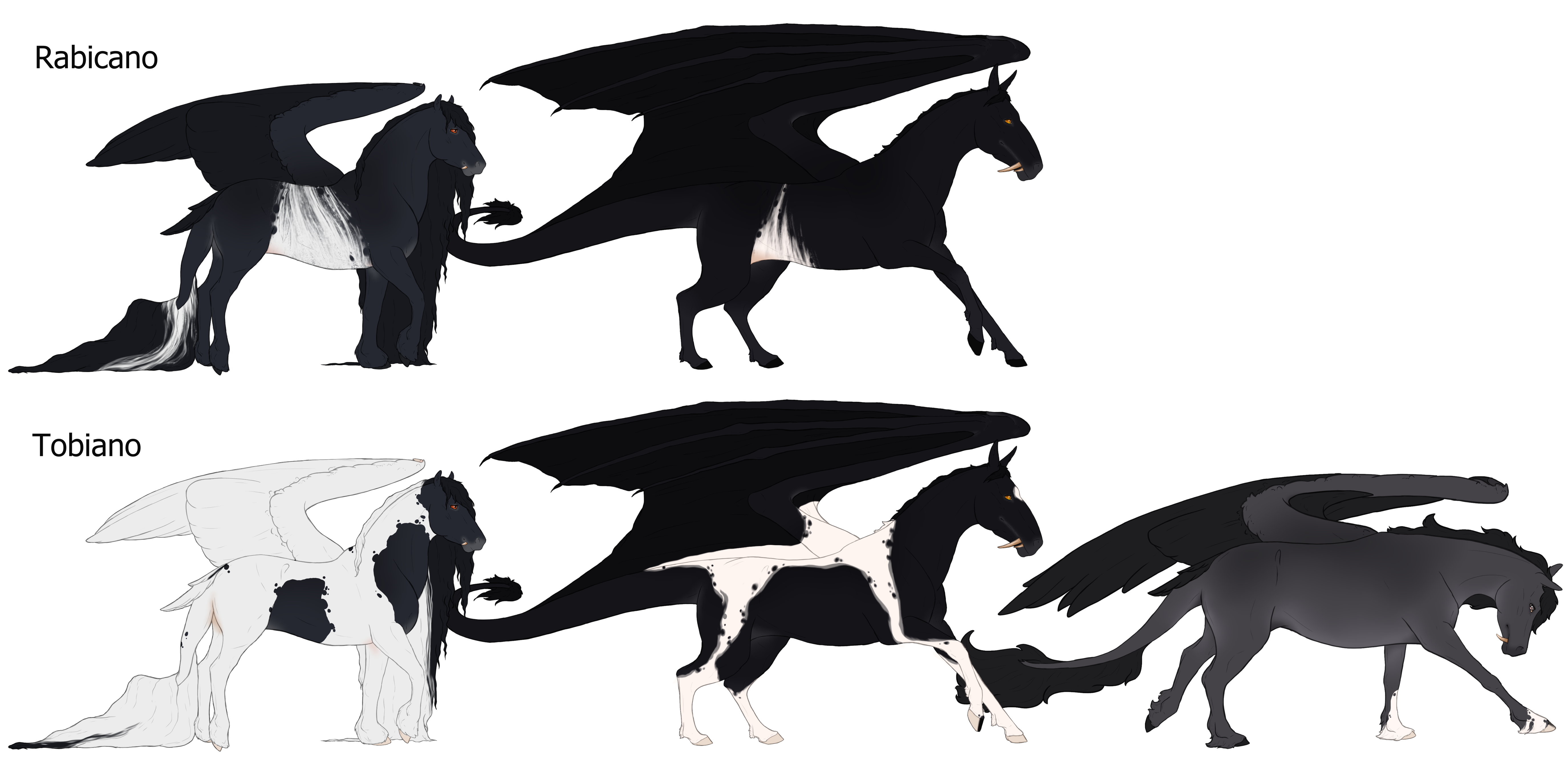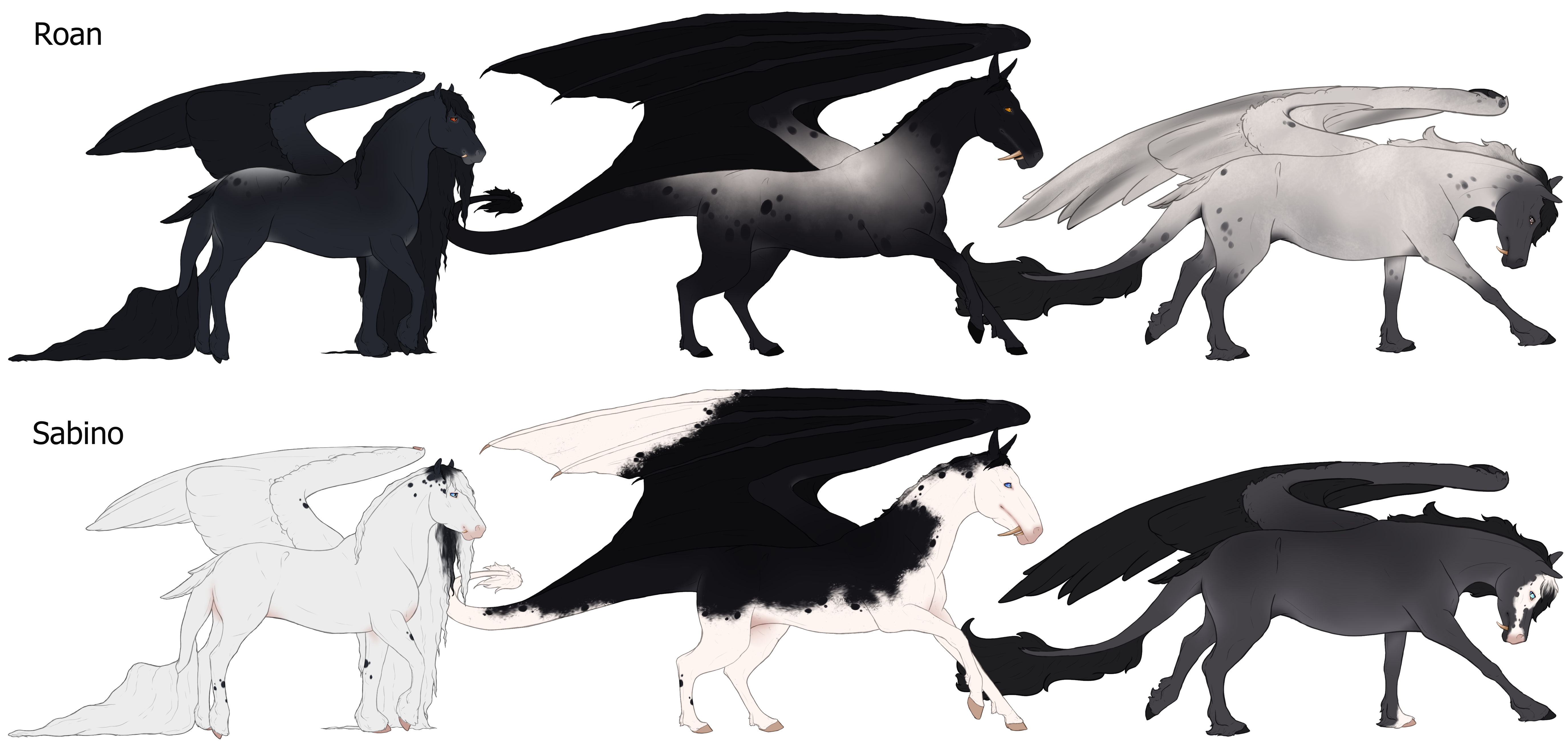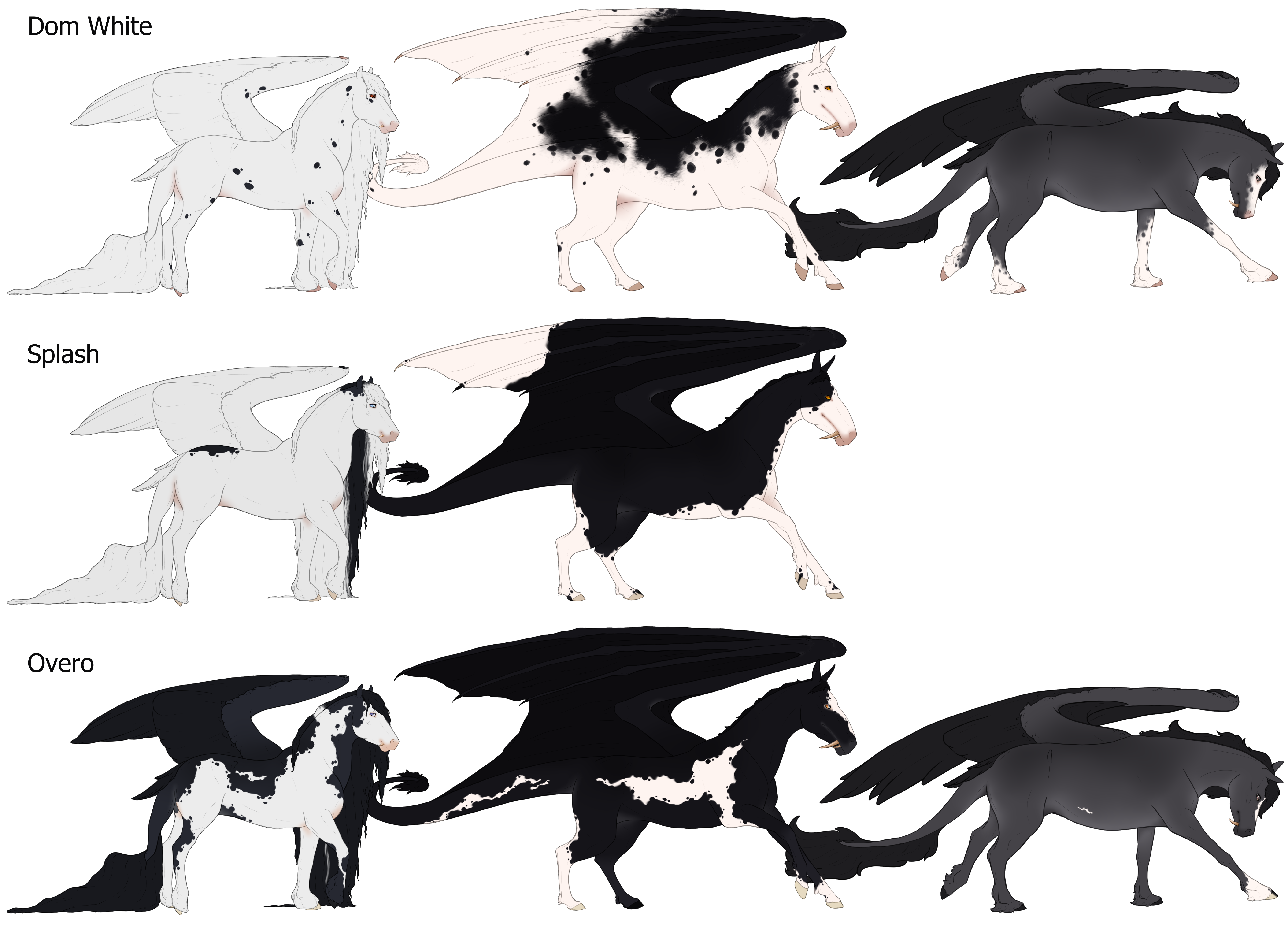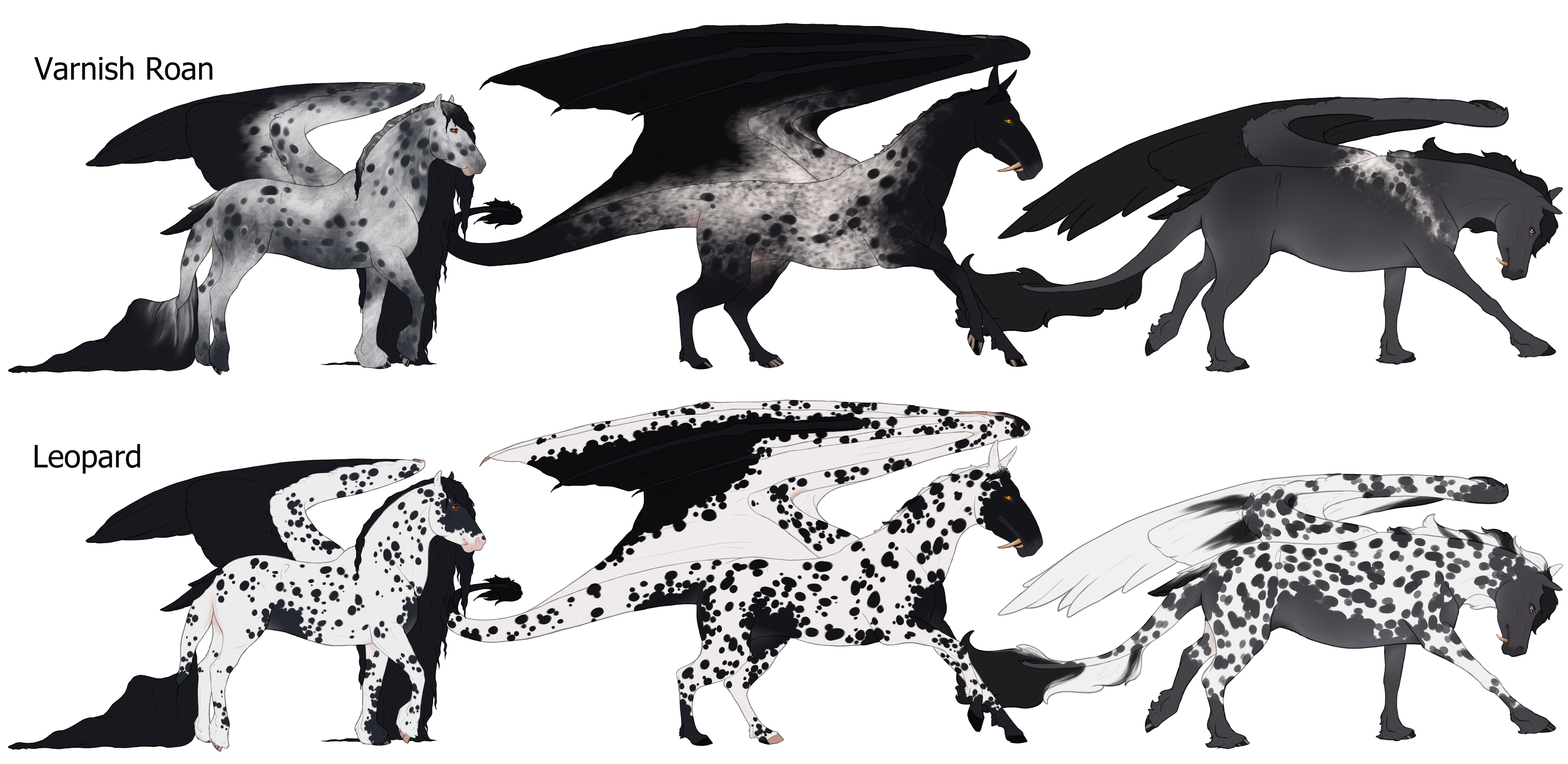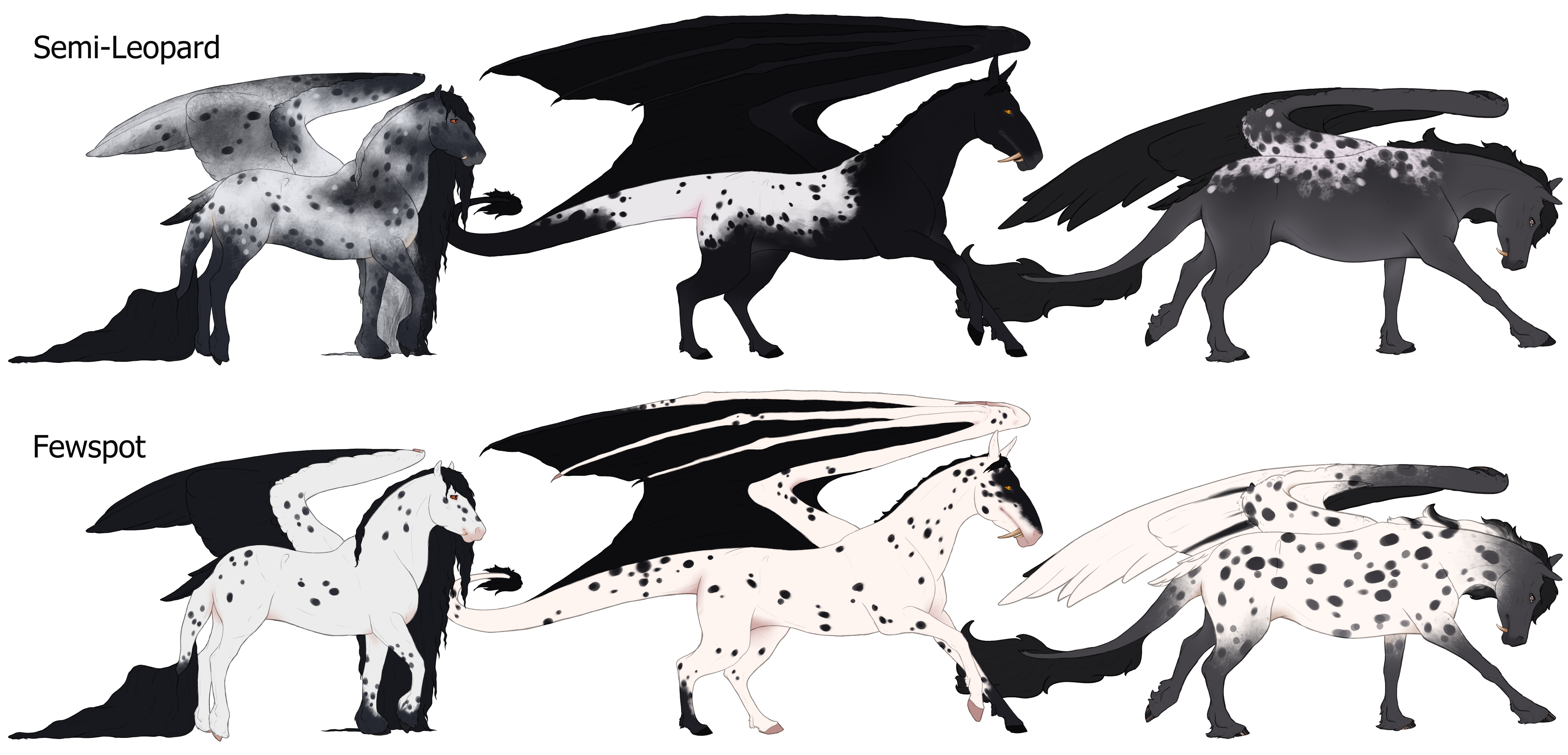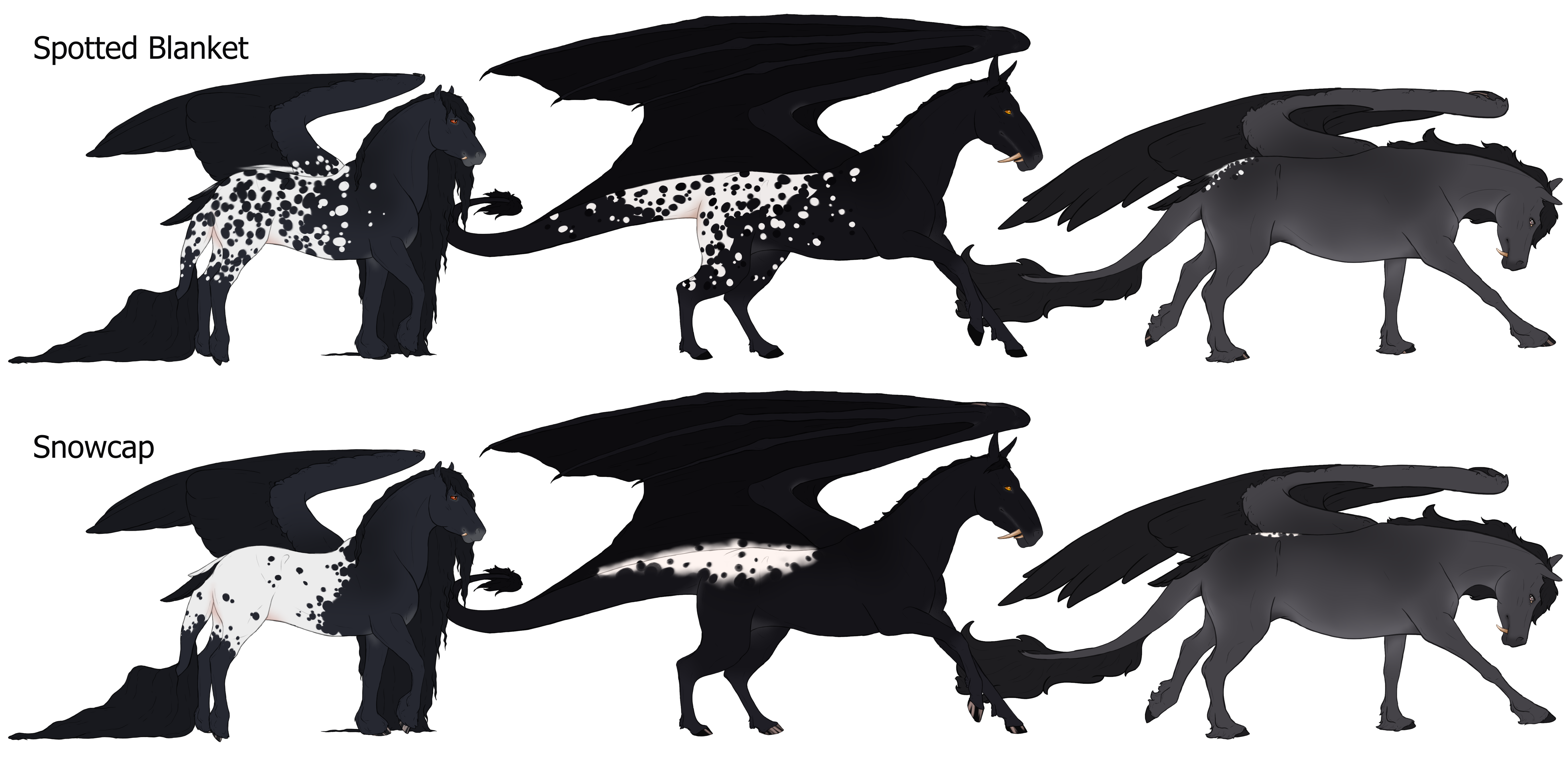Traits
Snowflake[-sf] (Free)
Snowflake | [-sf]
Trait Count - 3
Snowflake is a double expression of appaloosa. It will only show WITH another appaloosa gene, so like nLp(roan-sf) which would be a varnish roan snowflake.
Snowflake shows with mutations that suppress appaloosa genes. It's currently unknown as to why.
Snowflake will reflect the density of the appaloosa present, so a minimal appaloosa won't have a maximal snowflake.
Snowflake Examples
Varnish Roan[Lp[roan]] (Common)
nLp[roan] | LpLp[roan]
Trait Count - 3
Varnish Roan is the most basic variation of the leopard complex gene and is the foundation for other variants. Varnish is always heavily textured and in more maximum expression can sometimes be mistaken as a fewspot appaloosa. 'Corn spots' are always found on varnish roans as it is an appaloosa gene, there will never be a large number of them, but are typically more frequent than corn spots on a kit roan.
- Flight feathers and webbing can be white where marking touches.
- Mane and tail can be white where marking touches.
- Wings and mane can be affected separately by varnish.
Varnish Roan Range
Blue is the minimum required expression.
Yellow is the maximum optional expression.
Red is the area expression is not allowed.
The white palettes provided are a simple guide, as different coats will likely have different tinted whites. Though, these guides do set what the palest possible natural white can be in terms of hex code. Anything that is paler than the palettes will be asked to be changed.
The below palettes go as white intended for a black - bay - chestnut from left to right. Warm coats will have warm toned white, while cool tones will have cool toned whites.
Minimum Expression Examples
Medium Expression Examples
Maximum Expression Examples
Spotted Blanket[nLp[spot]] (Common)
nLp[spot]
Trait Count - 1
Spotted blanket is pretty much a marking of its name. It creates a blanket along the back of a horse filled with holes.
- Can have darker and white spots across their body.
- Skin can be molted and hooves can be striped.
- In breeding LpLp[spot] will become LpLp[snow].
Spotted Blanket Range
Blue is the minimum required expression.
Yellow is the maximum optional expression.
Red is the area expression is not allowed. Edge spotting is allowed to go into this range, as long as it's not a large amount.
The white palettes provided are a simple guide, as different coats will likely have different tinted whites. Though, these guides do set what the palest possible natural white can be in terms of hex code. Anything that is paler than the palettes will be asked to be changed.
The below palettes go as white intended for a black - bay - chestnut from left to right. Warm coats will have warm-toned white, while cool tones will have cool-toned whites.
Spotted Blanket Minimum Expression Examples
Spotted Blanket Medium Expression Examples
Spotted Blanket Maximum Expression Examples
Snowcap[LpLp[snow]] (Common)
LpLp[snow]
Trait Count - 1
Snowcap is more or less the solid version of spotted blanket. It covers about the same area, its edges can be harsh or soft, but will never be a full gradient.
- Skin can be molted and hooves can be striped.
- In breeding nLp[snow] will become nLp[spot].
Snowcap Range
Blue is the minimum required expression.
Yellow is the maximum optional expression.
Red is the area expression is not allowed.
The white palettes provided are a simple guide, as different coats will likely have different tinted whites. Though, these guides do set what the palest possible natural white can be in terms of hex code. Anything that is paler than the palettes will be asked to be changed.
The below palettes go as white intended for a black - bay - chestnut from left to right. Warm coats will have warm toned white, while cool tones will have cool toned whites.
Minimum Expression Examples
Medium Expression Examples
Maximum Expression Examples
Leopard[nLp[leop]] (Uncommon)
nLp[leop]
Trait Count - 2
Leopard appaloosa covers the body in white, similar to dom white, but instead of being solid in color, it has spots displaying the coat underneath.
- Flight feathers and webbing can be white where marking touches.
- Mane and tail can be white where marking touches.
- Hooves can be striped or solid.
Leopard Appaloosa Range
Blue is the minimum required expression.
Yellow is the maximum optional expression.
Red is the area expression is not allowed.
The white palettes provided are a simple guide, as different coats will likely have different tinted whites. Though, these guides do set what the palest possible natural white can be in terms of hex code. Anything that is paler than the palettes will be asked to be changed.
The below palettes go as white intended for a black - bay - chestnut from left to right. Warm coats will have warm toned white, while cool tones will have cool toned whites.
Minimum Expression Examples
Medium Expression Examples
Maximum Expression Examples
Snowspot[Lp[sspot]] (Uncommon)
nLp[sspot] | LpLp[ssnpot]
Trait Count - 2
Snowspot is a appaloosa modifier that progresses as a BA ages. It always starts along the topline, and progresses towards the belly.
- Snowspot will always affect the mane, tail, and wings in higher expressions.
- When paired with snowflake, snowflake will also progress and expand on the coat.
When uploading and designing a snowspot, you can optionally include a later or earlier stage than their normal design. This is not required, but do keep in mind that snowspot progresses with age!
Snowspot Range
Blue is the minimum required expression.
Yellow is the maximum optional expression.
Red is the area expression is not allowed,
Snowspot Minimum Expression Examples
Snowspot Medium Expression Examples
Snowspot Maximum Expression Examples
Inverse[!] L (Uncommon)
Mismark[-m] (Uncommon)
Mismarked | [-m]
Trait Count - 3
Mismark is essentially blood marks for appaloosas. It will only show when present with an appaloosa gene, so like nLp(roan-m) which would be a mismarked varnish roan.
The edges of mismark will reflect the type of appaloosa it's tied to. So a leopard might have a hard-edge mismark, while a varnish has a soft one.
Mismark Examples
Semi Leopard[Lp[semi]] (Rare)
nLp[semi] | LpLp[semi]
Trait Count - 3
Semi leopard is a somewhat strange expression of appaloosa but is the most flexible in its expression. Semi can mimic other types of appaloosa, which can sometimes cause it to be mistaken for other expressions, it can also sometimes look like combinations of two different expressions.
Semi Leopard Range
Blue is the minimum required expression.
Yellow is the maximum optional expression.
Red is the area expression is not allowed.
The white palettes provided are a simple guide, as different coats will likely have different tinted whites. Though, these guides do set what the palest possible natural white can be in terms of hex code. Anything that is paler than the palettes will be asked to be changed.
The below palettes go as white intended for a black - bay - chestnut from left to right. Warm coats will have warm-toned white, while cool tones will have cool-toned whites.
Minimum Expression Examples
Medium Expression Examples
Maximum Expression Examples
Fewspot[LpLp[fews] (Rare)
LpLp[fews]
Trait Count - 3
Fewspot appaloosa covers the body in white and has spots showing the base coat, very similar to leopard appaloosas. The difference is fewspots have less spots, but also have three areas where you'll see the base coat. They will have textured edges on these areas, they can be different sizes, but there will always be at least three obvious spots of these gaps.
Fewspot Range
Blue is the minimum required expression.
Yellow is where a decent majority of spots are.
Red is the area expression is not allowed.
The white palettes provided are a simple guide, as different coats will likely have different tinted whites. Though, these guides do set what the palest possible natural white can be in terms of hex code. Anything that is paler than the palettes will be asked to be changed.
The below palettes go as white intended for a black - bay - chestnut from left to right. Warm coats will have warm toned white, while cool tones will have cool toned whites.
Minimum Expression Examples
Medium Expression Examples
Maximum Expression Examples
Abstract[~] L (Rare)
Peacock[-pc] (Extremely Rare)
Birdcatcher Spots[Bi] (Free)
nBi | BiBi
Trait Count - 0
Birdcatcher spots are simple white spots across a BA's body. They are similar to snowflake but differ in the fact they are their own standalone gene. Snowflake and birdcatcher spots do interact and can make a very spotty appaloosa.
- Birdcatcher spots do not affect the mane or wings.
Birdcatcher
The absolute minimum number of birdcatcher spots is 2, these can be on the off-side from the import sheets, but must be stated when submitting designs.
The Angel displays both the minimum and the smallest size birdcatcher spots can be.
The Nephilim is displaying both a more maximal expression and the biggest size spots can be.
Grease Spots[Gr] (Free)
nGr | GrGr
Trait Count - 0
Grease spots is best described as the dark version of birdcatcher and chubari. It leaves dark spots in varying sizes over the coat.
- Grease spots does not affect the mane, wings, skin, and hooves.
Grease
The absolute minimum number of greasespots is 2, these can be on the off-side from the import sheets, but must be stated when submitting designs.
The Angel displays both the minimum and the smallest size grease spots can be.
The Nephilim is displaying both a more maximal expression and the biggest size spots can be.
Glitter Birdcatcher Spots[Big] (Common)
Glitter Grease Spots[Grg] (Common)
Belton Spots[Be] (Uncommon)
Brindle[Br] (Uncommon)
Chubari Spots[Cu] (Uncommon)
nCu | CuCu
Trait Count - 2
Chubari spots, sometimes misinterpreted as inverse appaloosa, is a gene that displays as large spots across the body. These spots are never small, and love to bunch up and layer over one another.
- Chubari spots affect the mane, wings, skin, and hooves where they touch.
Chubari
The absolute minimum number of chubari spots is 2, these can be on the off-side from the import sheets, but must be stated when submitting designs.
The Angel displays both the minimum and the smallest size chubari spots can be.
The Nephilim is displaying both a more maximal expression and the biggest size spots can be.
Vitiligo[V] (Uncommon)
nV | VV
Trait Count - 2
Vitiligo causes a BA to lose pigment in their skin and fur, similar to in humans. Foals will have next to no, or no visible spotting, as vitiligo develops with age.
In BAs, vitiligo stays around where there is exposed skin on the body, so the eyes, mouth, nose, etc. Eye and mane are unaffected by vitiligo.
Vitiligo spotting tends to start on the face and groin area of a BA and is always white in color and turns the skin pink.
Vitiligo General Range
Blue is the minimum required expression.
Yellow is the maximum optional expression.
Red is the area expression is not allowed.
Vitiligo Examples





















